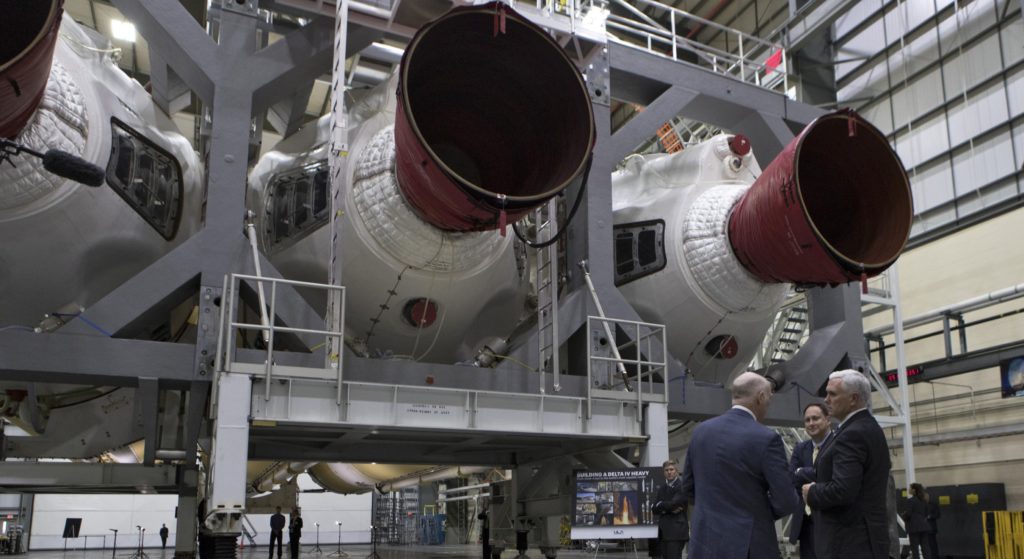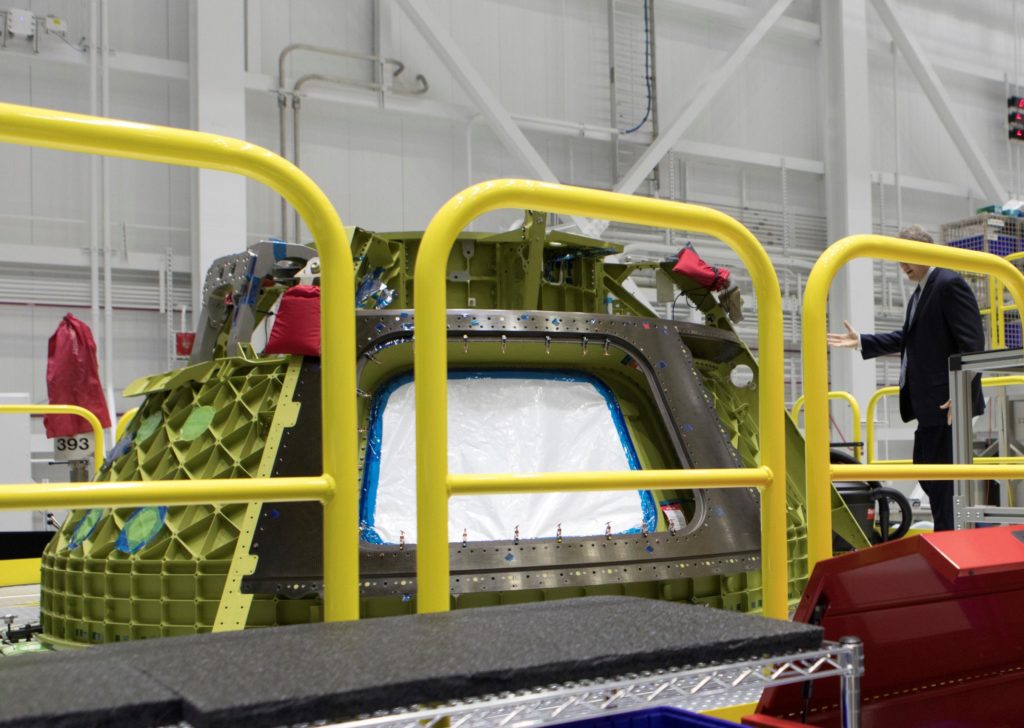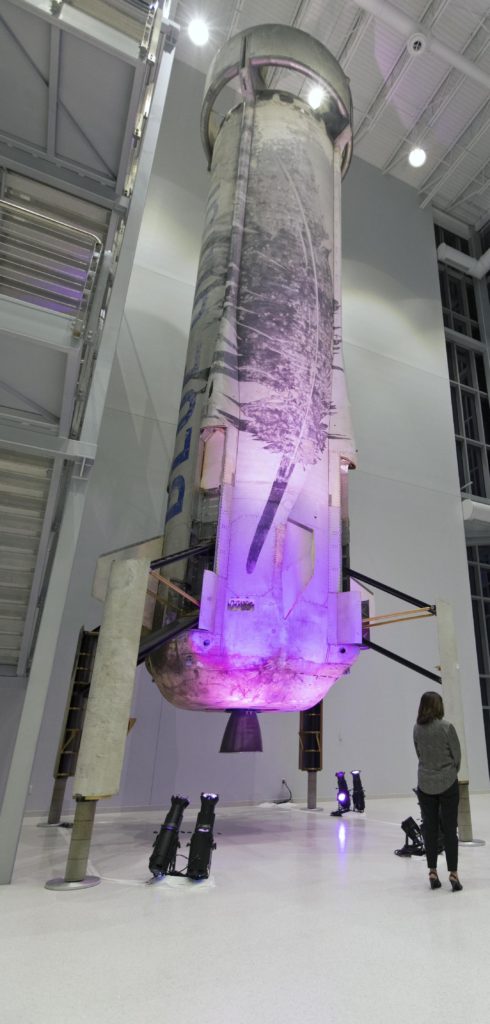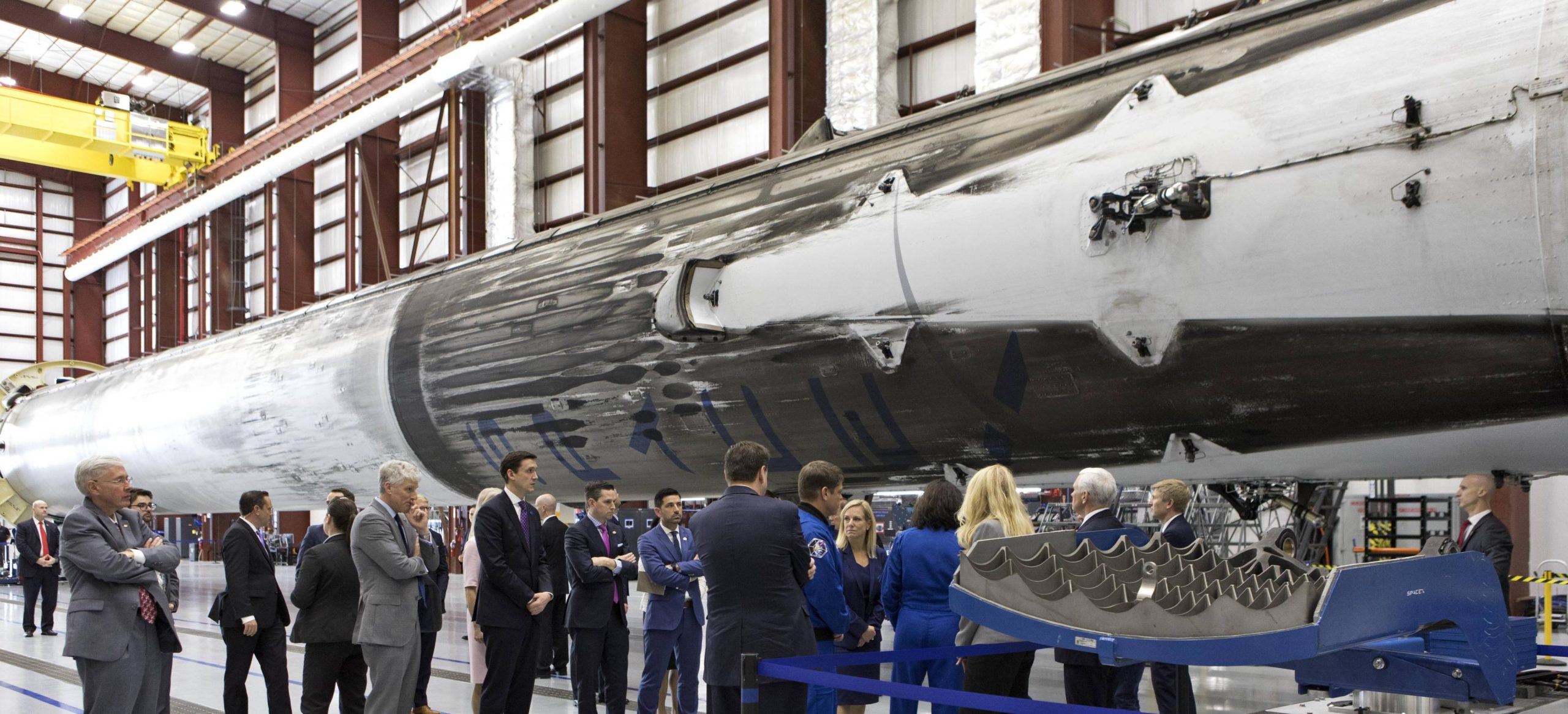
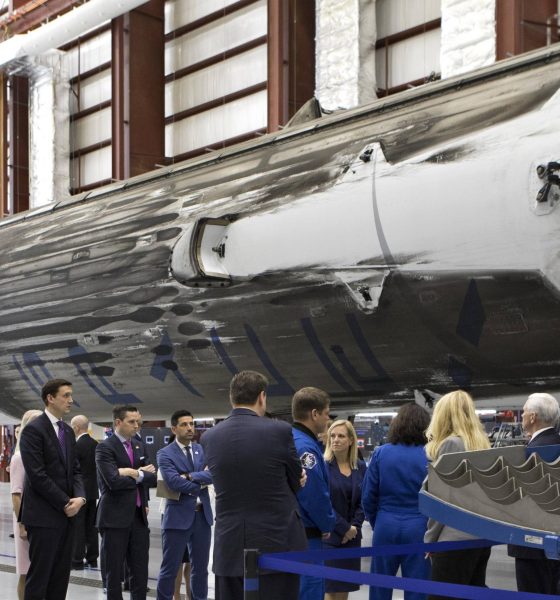
News
SpaceX shows off Starman helmet and Falcon Heavy to political VIPs
In the wake of the rather odd second meeting of the US National Space Council (NSC), a NASA photographer stationed at Kennedy Space Center documented a number of tours given by some of the companies mentioned in the proceedings. VIPs who attended the NSC were allowed to get up close and personal to rocket hardware in facilities owned and operated by SpaceX, Blue Origin, Boeing, the United Launch Alliance (ULA), and others, and in a few cases provided some unique views of those same facilities.
RELATED: SpaceX vs. Blue Origin: The bickering titans of new space
Humorously enough, those tours – at least as seen through the lenses of NASA photographer Kim Shiflett – acted as a generally accurate thematic representation of each company. ULA walked VIPs through their Delta IV Heavy integration facility, ready for the launch of a NASA spacecraft tasked with traveling closer to the sun than any vehicle before it – the impressive but oft-maligned rocket’s first launch in nearly two years.
Boeing displayed some of their Starliner hardware, hoped to carry their first crew to the International Space Station in very late 2018 or early 2019. Blue Origin showed off a massive factory – intended to eventually manufacture their orbital New Glenn rocket – that was, by all appearances, almost completely empty, aside from a flight-proven New Shepard and boilerplate capsule now on display in the lobby.
- ULA president and CEO Tory Bruno, left leads a tour of the Delta IV Heavy rocket for VP Mike Pence. (NASA)
- Boeing, one of the two companies that comprise ULA, gave NSC VIPs a tour of the facility where they are assembling Starliner crew capsules. (NASA)
- Blue Origin’s seemingly empty New Glenn factory. The massive rocket is hoped to complete its first launch NET 2020. (NASA)
- Blue Origin has had some success with its New Shepard suborbital rocket reuse program, although dramatically different from New Glenn. (NASA)
SpaceX, however, undertook the (admittedly less than titanic) feat of overshadowing its fellow aerospace companies. Something like 80% coincidence and 20% theatrics, SpaceX’s displays included two of the just-launched and just-landed Falcon Heavy boosters – one accessible by all at the Kennedy Space Center Visitor Center, the other recently shuttled into the company’s facilities at Pad 39A. While the company appears not to have opened their second LC-40 pad for tours this time around, Space Council VIPs were given a unique mass-tour of Pad 39A’s Horizontal Integration Facilities, chock full of flight-proven orbital rockets and components.
- Titanium grid fins complete the highly reusable changes to Block 5 of Falcon 9. (NASA)
- A unique perspective of SpaceX’s upgraded grid fin – dwarfing its human onlookers. (NASA)
- Shotwell, pictured on the right, spoke in depth about SpaceX’s profitability and synergies with Tesla’s battery expertise. (NASA)
- (NASA)
On display was the second Falcon Heavy side booster, a Falcon 9-equivalent first stage that took part in the inaugural launch of the massive rocket just two weeks before, as well as one of that booster’s highly valuable titanium grid fins, providing a unique sense of scale (spoiler: they’re colossal). Further, after what can only be described as Starman’s iconic global debut, SpaceX brought along the helmet of one of their slick internally-designed spacesuits, going so far as to let members of the tour – including the Secretary of the Air Force – briefly try it on for themselves.
.@NASA I’m ready to go. When’s the next launch? pic.twitter.com/XC21RFEw5C
— Office of the Secretary of the Air Force (@SecAFOfficial) February 21, 2018
Despite the baffling fact that none of the actual hardware developers that gave tours after had seats on either of the two panels that spoke before the Council, it’s great to see SpaceX flaunt at least a portion of its extraordinary and praiseworthy achievements in the last few months alone.
Whether or not you resent some of the politicking or the actors involved in the spectacle, the general theme of reducing and improving regulatory burdens on US aerospace companies is one of the very few places where there is actually some truth to the negativity. Jingoistic China-bashing and hyperbole aside, some of the panelists and councilmembers made reasonable points about the state of spaceflight regulation, and some of their recommendations may actually benefit companies like Blue Origin, ULA, and SpaceX – at least eventually.
Catch our live, behind-the-scenes coverage of these exciting events through the eyes of our amazing photographers on both coasts.
Teslarati – Instagram – Twitter
Tom Cross – Twitter
Pauline Acalin – Twitter
Eric Ralph – Twitter

News
Tesla (TSLA) receives “Buy” rating and $551 PT from Canaccord Genuity
He also maintained a “Buy” rating for TSLA stock over the company’s improving long-term outlook, which is driven by autonomy and robotics.

Canaccord Genuity analyst George Gianarikas raised his Tesla (NASDAQ:TSLA) price target from $482 to $551. He also maintained a “Buy” rating for TSLA stock over the company’s improving long-term outlook, which is driven by autonomy and robotics.
The analyst’s updated note
Gianarikas lowered his 4Q25 delivery estimates but pointed to several positive factors in the Tesla story. He noted that EV adoption in emerging markets is gaining pace, and progress in FSD and the Robotaxi rollout in 2026 represent major upside drivers. Further progress in the Optimus program next year could also add more momentum for the electric vehicle maker.
“Overall, yes, 4Q25 delivery expectations are being revised lower. However, the reset in the US EV market is laying the groundwork for a more durable and attractive long-term demand environment.
“At the same time, EV penetration in emerging markets is accelerating, reinforcing Tesla’s potential multi‑year growth runway beyond the US. Global progress in FSD and the anticipated rollout of a larger robotaxi fleet in 2026 are increasingly important components of the Tesla equity story and could provide sentiment tailwinds,” the analyst wrote.
Tesla’s busy 2026
The upcoming year would be a busy one for Tesla, considering the company’s plans and targets. The autonomous two-seat Cybercab has been confirmed to start production sometime in Q2 2026, as per Elon Musk during the 2025 Annual Shareholder Meeting.
Apart from this, Tesla is also expected to unveil the next-generation Roadster on April 1, 2026. Tesla is also expected to start high-volume production of the Tesla Semi in Nevada next year.
Apart from vehicle launches, Tesla has expressed its intentions to significantly ramp the rollout of FSD to several regions worldwide, such as Europe. Plans are also underway to launch more Robotaxi networks in several more key areas across the United States.
News
Waymo sues Santa Monica over order to halt overnight charging sessions
In its complaint, Waymo argued that its self-driving cars’ operations do not constitute a public nuisance, and compliance with the city’s order would cause the company irreparable harm.

Waymo has filed a lawsuit against the City of Santa Monica in Los Angeles County Superior Court, seeking to block an order that requires the company to cease overnight charging at two facilities.
In its complaint, Waymo argued that its self-driving cars’ operations do not constitute a public nuisance, and compliance with the city’s order would cause the company irreparable harm.
Nuisance claims
As noted in a report from the Los Angeles Times, Waymo’s two charging sites at Euclid Street and Broadway have operated for about a year, supporting the company’s growing fleet with round-the-clock activity. Unfortunately, this has also resulted in residents in the area reportedly being unable to sleep due to incessant beeping from self-driving taxis that are moving in and out of the charging stations around the clock.
Frustrated residents have protested against the Waymos by blocking the vehicles’ paths, placing cones, and “stacking” cars to create backups. This has also resulted in multiple calls to the police.
Last month, the city issued an order to Waymo and its charging partner, Voltera, to cease overnight operations at the charging locations, stating that the self-driving vehicles’ activities at night were a public nuisance. A December 15 meeting yielded no agreement on mitigations like software rerouting. Waymo proposed changes, but the city reportedly insisted that nothing would satisfy the irate residents.
“We are disappointed that the City has chosen an adversarial path over a collaborative one. The City’s position has been to insist that no actions taken or proposed by Waymo would satisfy the complaining neighbors and therefore must be deemed insufficient,” a Waymo spokesperson stated.
Waymo pushes back
In its legal complaint, Waymo stated that its “activities at the Broadway Facilities do not constitute a public nuisance.” The company also noted that it “faces imminent and irreparable harm to its operations, employees, and customers” from the city’s order. The suit also stated that the city was fully aware that the Voltera charging sites would be operating around the clock to support Waymo’s self-driving taxis.
The company highlighted over one million trips in Santa Monica since launch, with more than 50,000 rides starting or ending there in November alone. Waymo also criticized the city for adopting a contentious strategy against businesses.
“The City of Santa Monica’s recent actions are inconsistent with its stated goal of attracting investment. At a time when the City faces a serious fiscal crisis, officials are choosing to obstruct properly permitted investment rather than fostering a ‘ready for business’ environment,” Waymo stated.
News
Tesla FSD v14.2.2 is getting rave reviews from drivers
So far, early testers have reported buttery-smooth drives with confident performance, even at night or on twisty roads.

Tesla Full Self-Driving (Supervised) v14.2.2 is receiving positive reviews from owners, with several drivers praising the build’s lack of hesitation during lane changes and its smoother decision-making, among others.
The update, which started rolling out on Monday, also adds features like dynamic arrival pin adjustment. So far, early testers have reported buttery-smooth drives with confident performance, even at night or on twisty roads.
Owners highlight major improvements
Longtime Tesla owner and FSD user @BLKMDL3 shared a detailed 10-hour impression of FSD v14.2.2, noting that the system exhibited “zero lane change hesitation” and “extremely refined” lane choices. He praised Mad Max mode’s performance, stellar parking in locations including ticket dispensers, and impressive canyon runs even in dark conditions.
Fellow FSD user Dan Burkland reported an hour of FSD v14.2.2’s nighttime driving with “zero hesitations” and “buttery smooth” confidence reminiscent of Robotaxi rides in areas such as Austin, Texas. Veteran FSD user Whole Mars Catalog also demonstrated voice navigation via Grok, while Tesla owner Devin Olsen completed a nearly two-hour drive with FSD v14.2.2 in heavy traffic and rain with strong performance.
Closer to unsupervised
FSD has been receiving rave reviews, even from Tesla’s competitors. Xpeng CEO He Xiaopeng, for one, offered fresh praise for FSD v14.2 after visiting Silicon Valley. Following extended test drives of Tesla vehicles running the latest FSD software, He stated that the system has made major strides, reinforcing his view that Tesla’s approach to autonomy is indeed the proper path towards autonomy.
According to He, Tesla’s FSD has evolved from a smooth Level 2 advanced driver assistance system into what he described as a “near-Level 4” experience in terms of capabilities. While acknowledging that areas of improvement are still present, the Xpeng CEO stated that FSD’s current iteration significantly surpasses last year’s capabilities. He also reiterated his belief that Tesla’s strategy of using the same autonomous software and hardware architecture across private vehicles and robotaxis is the right long-term approach, as it would allow users to bypass intermediate autonomy stages and move closer to Level 4 functionality.
